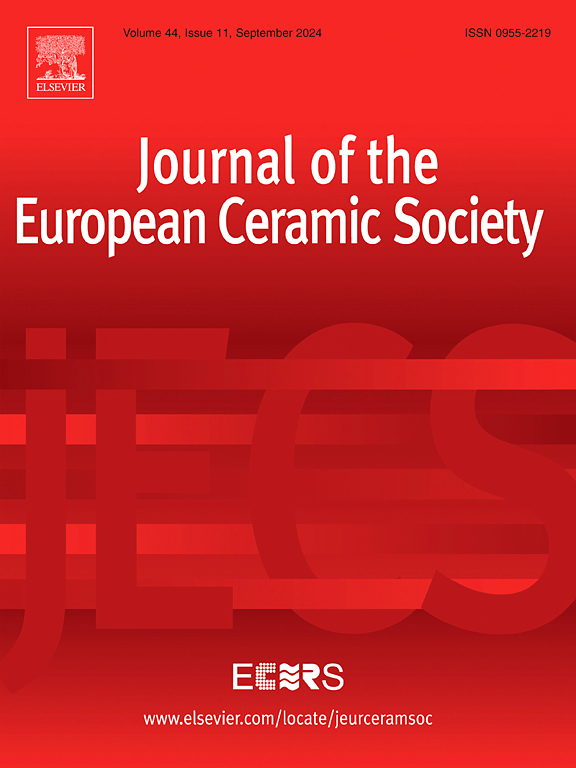Y3Si2C2陶瓷的快速合成与增材制造:超快高温烧结与直接油墨书写相结合
IF 6.2
2区 材料科学
Q1 MATERIALS SCIENCE, CERAMICS
Journal of The European Ceramic Society
Pub Date : 2025-06-06
DOI:10.1016/j.jeurceramsoc.2025.117610
引用次数: 0
摘要
采用超快高温烧结(UHS)技术,通过Y和SiC的原位反应制备了Y3Si2C2粉体,这是首次以超高速率合成稀土硅酸盐(RE3Si2C2)。相分析表明,在1050℃下得到了相对纯净的Y3Si2C2产物,具有明显的片层形貌。利用合成的Y3Si2C2粉末制备剪切减薄型油墨,优化后的乳化型油墨与直墨书写相结合,实现了蜂窝结构的精确制备,并在烧结后表现出优异的力学性能。与具有低加热速率(~ 10°C/min)和长停留时间(~ 2 h)的传统烧结工艺相比,UHS可以在更短的时间(~ 50 s)和更低的温度(~ 950°C)下有效地合成Y3Si2C2。本文提出的制备和成型方法的集成,为Y3Si2C2在复杂结构陶瓷中的应用开辟了新的前景。本文章由计算机程序翻译,如有差异,请以英文原文为准。
Rapid synthesis and additive manufacturing of Y3Si2C2 ceramics: Ultrafast high-temperature sintering combined with direct ink writing
Y3Si2C2 powders were successfully fabricated through the in situ reaction of Y and SiC using ultrafast high-temperature sintering (UHS), which is the first attempt to synthesize rare-earth silicates (RE3Si2C2) at an ultrahigh rate. Phase analysis reveals that a relatively pure Y3Si2C2 product is obtained at 1050 °C, exhibiting distinctive lamellar morphology. The synthesized Y3Si2C2 powder was then employed to formulate a shear-thinning ink, and an optimized emulsion-based ink combined with direct ink writing enabled the precise fabrication of honeycomb structures, which exhibited exceptional mechanical properties after sintering. Compared with conventional sintering processes featuring low heating rates (∼10 °C/min) and prolonged dwell times (∼2 h), UHS can efficiently synthesize Y3Si2C2 within significantly shorter times (∼50 s) and at lower temperatures (∼950 °C). The proposed integration of the preparation and forming methods paves the way for the exploration of novel perspectives in the application of Y3Si2C2 in complex-structure ceramics.
求助全文
通过发布文献求助,成功后即可免费获取论文全文。
去求助
来源期刊

Journal of The European Ceramic Society
工程技术-材料科学:硅酸盐
CiteScore
10.70
自引率
12.30%
发文量
863
审稿时长
35 days
期刊介绍:
The Journal of the European Ceramic Society publishes the results of original research and reviews relating to ceramic materials. Papers of either an experimental or theoretical character will be welcomed on a fully international basis. The emphasis is on novel generic science concerning the relationships between processing, microstructure and properties of polycrystalline ceramics consolidated at high temperature. Papers may relate to any of the conventional categories of ceramic: structural, functional, traditional or composite. The central objective is to sustain a high standard of research quality by means of appropriate reviewing procedures.
 求助内容:
求助内容: 应助结果提醒方式:
应助结果提醒方式:


